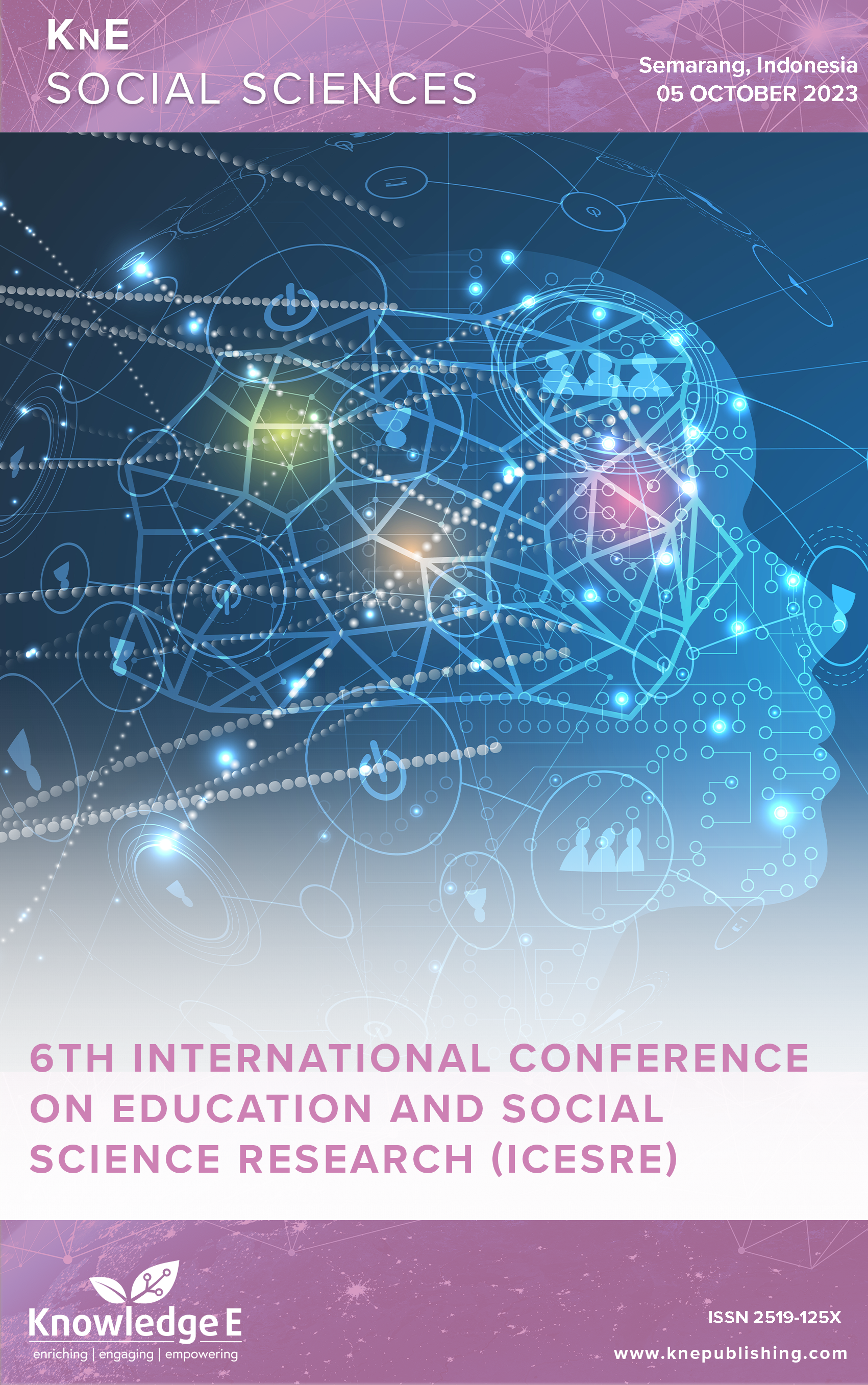Validation of a Mixed Reality-based Digital Book on the Topic of Algebra for Grade 7
DOI:
https://doi.org/10.18502/kss.v9i6.15325Abstract
In the current era, learning has been touched by technology that develops very rapidly, one of which is the book metamorphosis from print to digital form. Therefore, we need a book in digital form which is called a digital book. Digital books will be more interesting if they can turn our environment into a digital space. One technology that can present digital objects in the real world and interact with them using touch is mixed reality. The purpose of the study is to produce a mixed reality-based digital book that is valid for improving students’ numeracy literacy skills. This study used Borg and Gall’s research and development pattern method. The data were collected through expert validation for product testing. In media validation, which includes general aspects such as aspects of learning presentation, aspects of language feasibility, and graphic aspects, the result meets the valid criteria with an average score of 5 validators of 92.8%. Material validation includes general aspects such as, aspects of material substance, learning aspects, and beneficial aspects, the result meets the valid criteria with an average score from 5 validators of 92.4%. Based on the results of media and material validation of the digital book, it can be concluded that it is suitable for use. The implication of this study is to make it easier for students to learn using digital books.
Keywords: digital book, mixed reality, literacy, numeracy
References
Nurhayati D. Developing Interactive Digital Book for The Development of E-Learning Course on Educational Technology Students of Faculty of Science Education, Yogyakarta State University. E-Jurnal Prodi Teknologi Pendidikan 2017;VI:458–73.
Awang NH. BUKU VS E-BUKU: TRANSFORMASI ERA DIGITALJurnal PPM Vol. 5, 2011. Jurnal PPM 2010;5:1–14.
José Antonio Cordón-García, Daniel Linder RG-D and JA-A. E-Book publishing in Spain The paradoxes of a dual model. Journal of Enterprise Information Management 2016;29:118–39.
Park B, Chang H, Park S (Steven). Adoption of digital devices for children education: Korean case. Telematics and Informatics 2019;38:247–56. https://doi.org/10.1016/j.tele.2018.11.002. DOI: https://doi.org/10.1016/j.tele.2018.11.002
Lovenburg N. Journey within Afghanistan: Inside creative’s digital book tracking system. Childhood Education 2018;94:52–7. https://doi.org/10.1080/00094056.2018.1516473. DOI: https://doi.org/10.1080/00094056.2018.1516473
Hull SS, Chaparro BS. USABILITY EVALUATION OF DIGITAL FLIPVIEWER® ONLINE FLIPBOOKS 2006:1839–43. DOI: https://doi.org/10.1177/154193120605001726
Holz T, Campbell AG, Ohare GMP, Stafford JW, Martin A, Dragone M. MiRA-mixed reality agents. International Journal of Human Computer Studies 2011;69:251–68. https://doi.org/10.1016/j.ijhcs.2010.10.001. DOI: https://doi.org/10.1016/j.ijhcs.2010.10.001
Milgram P. A TAXONOMY OF MIXED REALITY VISUAL DISPLAYS. IEICE Transactions on Information Systems 2012;77:1–15.
Yusoff RCM, Ibrahim R, Zaman HB, Ahmad A. Evaluation of user acceptance of mixed reality technology. Australasian Journal of Educational Technology 2011;27:1369–87. https://doi.org/10.14742/ajet.899. DOI: https://doi.org/10.14742/ajet.899
Maas MJ, Hughes JM. Virtual, augmented and mixed reality in K–12 education: a review of the literature. Technology, Pedagogy and Education 2020;29:231–49. https://doi.org/10.1080/1475939X.2020.1737210. DOI: https://doi.org/10.1080/1475939X.2020.1737210
Kebudayaan KP dan. Gerakan Literasi Nasional 2017. http://gln.kemdikbud.go.id.
Agustina L, Martha Rusmana I. Pembelajaran Matematika Menyenangkan Dengan Aplikasi Kuis Online Quizizz. AL-IDARAH Jurnal Kependidikan Islam 2019;9:1–7.
Ekowati DW, Astuti YP, Utami IWP, Mukhlishina I, Suwandayani BI. Literasi Numerasi di SD Muhammadiyah. ELSE (Elementary School Education Journal) : Jurnal Pendidikan Dan Pembelajaran Sekolah Dasar 2019;3:93. https://doi.org/10.30651/else.v3i1.2541. DOI: https://doi.org/10.30651/else.v3i1.2541
Putri FS. Aplikasi Multimedia dan Model Pembelajaran Blended Learning untuk Literasi Numerasi Peserta Didik Sekolah Dasar. Jurnal Pendidikan 2022;22:155–61. https://doi.org/10.52850/jpn.v22i2.3918. DOI: https://doi.org/10.52850/jpn.v22i2.3918
Sugiyono. Metode Penelitian Pendekatan Kuantitatif Kualitatif dan R&D. Bandung: Alfabeta; 2016.
Suarsana IM, Mahayukti GA. PENGEMBANGAN E-MODUL BERORIENTASI PEMECAHAN MASALAH UNTUK MENINGKATKAN KETERAMPILAN BERPIKIR KRITIS MAHASISWA. Jurnal Nasional Pendidikan Teknik Informatika ( JANAPATI) 2013;2: 193. DOI: https://doi.org/10.23887/janapati.v2i3.9800
Rismayanti TA, Anriani N, Sukirwan S. Pengembangan E-Modul Berbantu Kodular pada Smartphone untuk Meningkatkan Kemampuan Berpikir Kritis Matematis Siswa SMP. Wilangan: Jurnal Inovasi Dan Riset Pendidikan Matematika 2022;3:203. https://doi.org/10.56704/jirpm.v3i3.13292. DOI: https://doi.org/10.56704/jirpm.v3i3.13292
Ernia N, Mahmudah W. Pengembangan e-modul berbasis problem-based learning untuk melatih literasi numerasi siswa. Primatika: Jurnal Pendidikan … 2023;12:61–70. DOI: https://doi.org/10.30872/primatika.v12i1.1612
Sandy DN, Cholily YM, Zukhrufurrohmah Z, Ummah SK. Pengembangan Flipbook Bermuatan Literasi Numerasi untuk Meningkatkan Kemampuan Komunikasi Matematis. Jurnal Tadris Matematika 2022;5:135–48. https://doi.org/10.21274/jtm.2022.5.2.135-148. DOI: https://doi.org/10.21274/jtm.2022.5.2.135-148
Hamiedah D, Fauziyah N, Huda S. Pengembangan E-modul Menggunakan Aplikasi Ispring Suite 10 dengan Penguatan Literasi Numerasi pada Peserta Didik SMP. DIDAKTIKA : Jurnal Pemikiran Pendidikan 2023;29:73. https://doi.org/10.30587/didaktika.v29i1.5176. DOI: https://doi.org/10.30587/didaktika.v29i1.5176
Nugroho AA, Purwati H. Pengembangan Media Pembelajaran Matematika Berbasis Mobile Learning Dengan Pendekatan Scientific. Euclid 2015;2. https://doi.org/10.33603/e.v2i1.355. DOI: https://doi.org/10.33603/e.v2i1.355
Utami RE, Nugroho AA, Dwijayanti I, Sukarno A. Pengembangan E-Modul Berbasis Etnomatematika Untuk Meningkatkan Kemampuan Pemecahan Masalah. JNPM ( Jurnal Nasional Pendidikan Matematika) 2018;2:268. https://doi.org/10.33603/jnpm.v2i2.1458. DOI: https://doi.org/10.33603/jnpm.v2i2.1458

